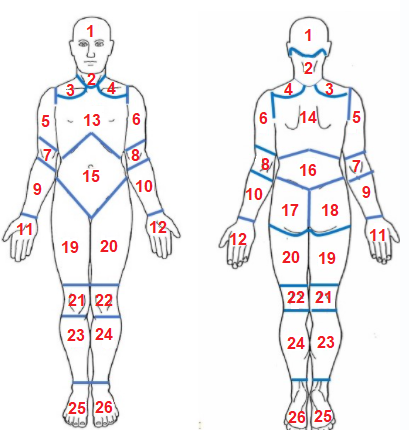Central Aspects of Pain (CAP) Questionnaire
The Central Aspects of Pain (CAP) questionnaire is a short, 8-item, 1-page questionnaire that measures a unitary factor (CAPf) linked to central nervous system aspects of pain. CAP may be a measurement tool for `nociplasticity’, a continuous trait linked to nociplastic pain. The CAP questionnaire comprises of 7 Likert response items and 1 body pain manikin.
Activities in the central nervous system (CNS; spinal cord and brain) govern our ability to describe pain intensity and our emotional response to pain. Changes in CNS pathways may explain an increased sensitivity to touch, pressure and movement. Chronic pain and altered CNS activity have been associated with symptoms of depression, anxiety, catastrophising, impaired cognitive function, sleep disturbance and fatigue. We have shown these characteristics load to a single Central Aspects of Pain factor, which is associated with quantitative sensory testing measures of central pain hypersensitivity.
The CAP questionnaire uses 8 items linked to CNS characteristics (fatigue, anxiety, depression, pain distribution, catastrophising, sleep disturbance, neuropathic-like pain, and cognitive impact). The questionnaire was initially developed with people with knee pain, combining expert and patient opinion, qualitative, factor and Rasch analyses to optimise measurement properties. (Akin-Akinyosoye et al., 2018, 2020, and 2021).
The CAP questionnaire measures a predominant contribution of CNS to pain variation. Rasch and Factor analyses indicated that CAP scores fit to a single-factor model, with good internal and external validity. The CAP questionnaire demonstrated external validity. CAPf was positively associated with pain severity, and quantitative sensory testing (QST) pressure pain detection thresholds (PPT) distal to an affected knee were better than any single measure associated with clinical characteristics (e.g. anxiety). CAPf also predicted pain persistence and persistent pain severity at 12 months follow up. The CAP questionnaire has been refined and further validated for people with low back pain, rheumatoid arthritis or fibromyalgia.
Arthritis UK Pain Centre is pursuing a series of projects funded by Arthritis UK, UKRI and NIHR building on our work with the CAP questionnaire. The Central Aspects of Pain in Rheumatoid Arthritis (CAP-RA) study [link to protocol paper], is using CAP to understand interactions between inflammation and CNS mechanisms in people with painful rheumatoid arthritis. The assessing central nervous systems contributions to accelerate musculoskeletal pain diagnosis and treatment (AsCent) project explores combining the self-report CAP questionnaire with QST to inform the management of painful musculoskeletal conditions. Another project is exploring pain phenotyping in people living with dementia (CAPPPeD) using CAP and QST.
Download the questionnaire
Scoring CAP 
Items 1-6 are scores 0 = Never, 1 = Sometimes, 2 = Often or Always.
Item 7 is reverse scored 2 = Never, 1 = Sometimes, 0 = Often or Always.
Item 8, the body pain manikin, is subdivided into 26 areas and scored based on the sum score of the shaded areas ≤ 9 shaded areas = 0, ≥ 10 shaded areas = 2.
The sum score of Items 1 to 8 gives a total CAP score in the range 0 to 16.
A single missing item should be imputed from the average of the 7 remaining items for that individual. Two or more missing items result in unreliable CAPf estimation.
View our publications on Central Aspects of Pain